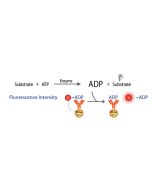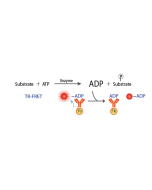Cookie Policy: This site uses cookies to improve your experience. You can find out more about our use of cookies in our Privacy Policy. By continuing to browse this site you agree to our use of cookies.
BellBrook
Transcreener ADP2 FP Assay

| Product Details | |
|---|---|
| Product Type | Kit |
| Properties | |
| Application Set | Compound Screening |
| Crossreactivity | All |
| Quantity |
1000 assays/384wells (BBL-3010-1K) 10000 assays/384wells (BBL-3010-10K) Note: The exact number of assays depends on enzyme reaction conditions. |
| Sensitivity | Excellent data quality (Z’ ≥ 0.7) at low substrate conversion (typically 10%). |
| Range | Accommodates ATP concentrations ranging from 0.1 μM to 1,000 μM. |
| Detection Type | Fluorescent polarization |
| Kit Contains |
ADP2 Antibody, ADP Alexa Fluor® 633 Tracer, Stop & Detect Buffer B, 10X, ATP, ADP Note: The plates are not included, please see manual for material not provided but necessary for assay. |
| Other Product Data |
Click here for Complete Information from the Original Manufacturer
Easy-to-Use (mix-and-read method).Simple homogenous biochemical assay. Direct detection of ADP eliminates laborious coupling steps. Non-radioactive, safe assay method. HTS Compatible with 96, 384, and 1536-well plates. Sensitive, robust detection of ADP. This means up to 10X less enzyme, a significant cost reduction on large screens. |
| Declaration | Manufactured by BellBrook Labs. |
| Shipping and Handling | |
| Shipping | DRY ICE |
| Short Term Storage | -20°C |
| Long Term Storage | -20°C |
| Handling Advice | Avoid freeze/thaw cycles. |
| Documents | |
| Manual |
 Download PDF Download PDF |
| Product Specification Sheet | |
| Datasheet |
 Download PDF Download PDF |
The Transcreener® HTS Assay platform overcomes the need for time-consuming, one-off assay development for individual members within a group transfer enzyme family by utilizing a single set of assay reagents that detect an invariant product. The generic nature of the Transcreener® HTS Assay platform eliminates delays involved in assay development for new HTS targets, and greatly simplifies compound and inhibitor profiling across multiple target families. Transcreener assays have been validated with major HTS instruments to determine the optimal filters and settings for maximal assay performance. Application notes with all important details are available.
The Transcreener ADP2 assay is available in three fluorescent readouts, Fluorescence polarization (FP), Fluorescence intensity (FI) and Time-resolved Forster-resonance-energy-transfer (TR-FRET), which provide a safe HTS-compatible alternative to cumbersome radioassay methods and are more sensitive and less subject to interference than other detection methods. All readouts use far-red tracers to minimize compound interference and lower false-positive rates.
The Transcreener® ADP2 FP Assay (Prod. No. BBL-3010) is a far-red, competitive fluorescence polarization (FP) assay. Because it is highly selective for ADP, the assay can be used with any enzyme that converts ATP to ADP, regardless of what other substrates are used. Examples of enzymes include protein, lipid, and carbohydrate kinases, ATPases, DNA helicases, carboxylases, and glutamine synthetase. The Transcreener® ADP2 Assay is a simple one step homogenous detection assay, and is extremely flexible with regard to ATP concentration (0.1 to 1,000 μM ATP). The assay provides excellent signal at low substrate conversion, with a Z’ = 0.7 and = 85 polarization shift (mP) at 10% ATP conversion using 1 μM ATP.
- Discovery of acetyl-coenzyme A carboxylase 2 inhibitors: comparison of a fluorescence intensity-based phosphate assay and a fluorescence polarization-based ADP Assay for high-throughput screening: Y. Liu, et al.; Assay Drug Dev. Technol. 5, 225 (2007)
- Development of a Transcreener™ Kinase Assay for Protein Kinase A and Demonstration of Concordance of Data with a Filter-Binding Assay Format: K.L. Huss, et al.; J. Biomol. Screen. 12, 578 (2007)
- Evaluating PI3 Kinase Isoforms Using Transcreener™ ADP Assays: T.A. Klink, et al.; J. Biomol. Screen. 13, 476 (2008)
- Characterization and optimization of a red-shifted fluorescence polarization ADP detection assay: K.M. Kleman-Leyer, et al.; Assay Drug Dev. Technol. 7, 56 (2009)
- Development and validation of a high-density fluorescence polarization-based assay for the trypanosoma RNA triphosphatase TbCet1: C. Antczak, et al.; Comb. Chem. High Throughput Screen. 12, 258 (2009)
- High-throughput, cell-free, liposome-based approach for assessing in vitro activity of lipid kinases: D.J. Demian, et al.; J. Biomol. Screen. 14, 838 (2009)
- Detection of the ATPase activity of the molecular chaperones Hsp90 and Hsp72 using the TranscreenerTM ADP assay kit: M. Rowlands, et al.; J. Biomol. Screen. 15, 279 (2010)
- High-throughput screening for RecA inhibitors using a transcreener adenosine 5'-O-diphosphate assay: E.J. Peterson, et al.; Assay Drug Dev. Technol. 10, 260 (2012)
- Dynamic steps in receptor tyrosine kinase mediated activation of class IA phosphoinositide 3-kinases (PI3K) captured by H/D exchange (HDX-MS): J.E. Burke & R.L. Williams, Adv. Biol. Regul. 53, 97 (2013)
- Evolutionarily conserved structural changes in phosphatidylinositol 5-phosphate 4-kinase (PI5P4K) isoforms are responsible for differences in enzyme activity and localization: J.H. Clarke&R.R. Irvine; Biochem. J. 454, 49 (2013)
- A novel CDK9 inhibitor shows potent antitumor efficacy in preclinical hematologic tumor models: T. Yin, et al.; Mol. Cancer Ther. 13, 1442 (2014)
- Development of a 3D Tissue Culture-Based High-Content Screening Platform That Uses Phenotypic Profiling to Discriminate Selective Inhibitors of Receptor Tyrosine Kinases: T.H. Booij, et al.; J. Biomol. Screen. 21, 912 (2016)
- A High-Throughput Method for Measuring Drug Residence Time Using the Transcreener ADP Assay: M. Kumar & R.G. Lowery; LSAS Discov. 22, 915 (2017)
- Treatment of Clostridium difficile Infection with a Small-Molecule Inhibitor of Toxin UDP-Glucose Hydrolysis Activity: I.L. Stroke, et al.; Antimicrob. Agents Chemother. 62, e00107 (2018)
- A Novel Inhibitor of the LolCDE ABC Transporter Essential for Lipoprotein Trafficking in Gram-Negative Bacteria: N.N. Nickerson, et al.; Antimicrob. Agents Chemother. 62, e02151 (2018)
- Structural basis for dual-mode inhibition of the ABC transporter MsbA: H. Ho, et al.; Nature 557, 196 (2018)
- Potent and selective inhibitors of receptor-interacting protein kinase 1 that lack an aromatic back pocket group: G.L. Hamilton, et al.; Bioorg. Med. Chem. 29, 1497 (2019)








